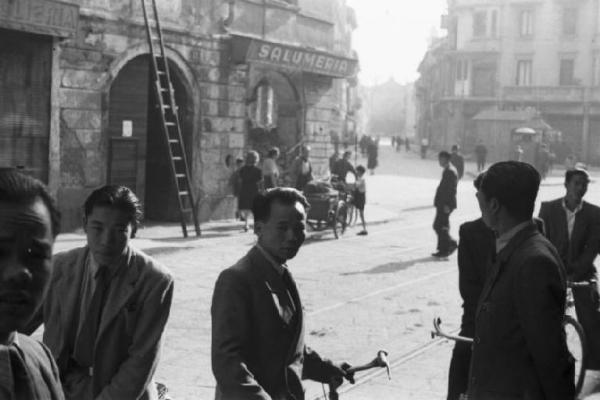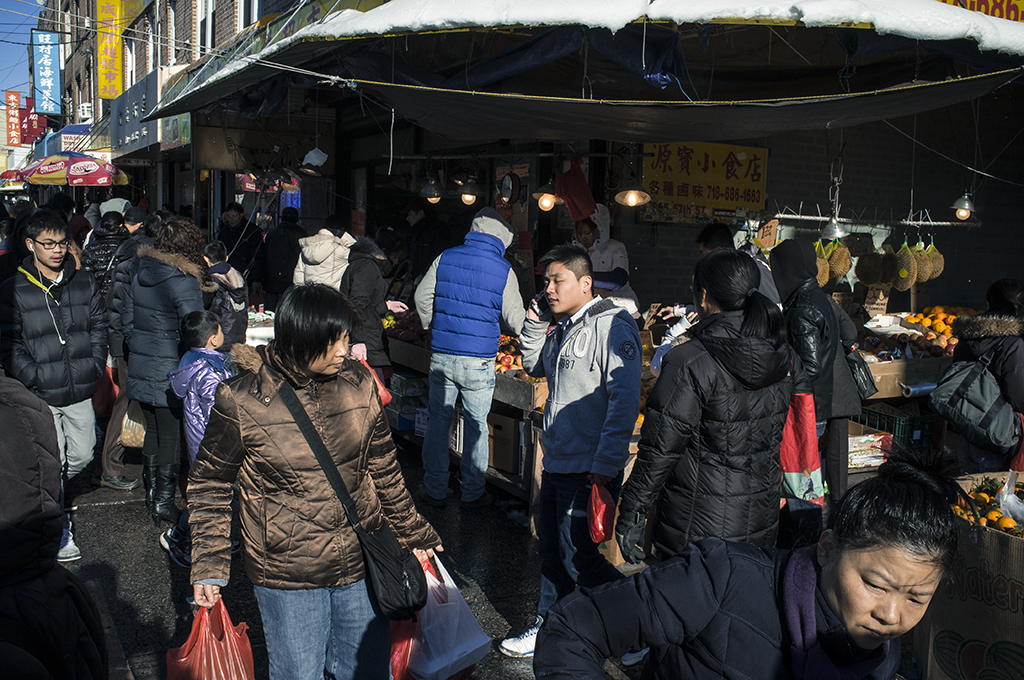|
Chinatown, Milan
Chinatown in Milan is an ethnic enclave situated in the 8th quarter of Milan (Italy), and it is an important commercial district. It is the oldest and largest Chinese community in Italy, with about 21,000 people in 2011. The Milanese Chinatown was originally established in via Canonica in the 1920s by immigrants from Wencheng County, in the Zhejiang province, and used to operate small textile and leather workshops. Today the district is filled with hairdressing salons, fashion boutiques, silk and leather stores, libraries, traveling agencies, medicine centres and massage parlours. The Chinese takeaways and restaurants in the area are mostly specialised in Zhejiang cuisine. Several Italian-Chinese companies are also headquartered in the neighborhood, including the editorial desk of the newspaper ''Europe China Daily''. Via Paolo Sarpi is the main street and is largely a pedestrian area. Other important locations are Via Bramante, Via Giovanni Battista Niccolini [...More Info...] [...Related Items...] OR: [Wikipedia] [Google] [Baidu] |
Ethnic Enclave
In sociology, an ethnic enclave is a geographic area with high ethnic concentration, characteristic cultural identity, and economic activity. The term is usually used to refer to either a residential area or a workspace with a high concentration of ethnic firms.Portes, Alejandro, and Leif Jensen. "Disproving the Enclave Hypothesis: Reply." ''American Sociological Review''. Vol. 57. no. 3 (1992): 418-420. Their success and growth depends on self-sufficiency, and is coupled with economic prosperity. The theory of social capital and the formation of migrant networks creates the social foundation for ethnic enclaves. Douglas Massey describes how migrant networks provide new immigrants with social capital that can be transferred to other tangible forms.Massey, Douglas S. "Annals of the American Academy of Political and Social Science." Annals of the American Academy of Political and Social Science. Vol. 510. World Population: Approaching the Year 2000 (Jul., 1990): pp. 60. As immigra ... [...More Info...] [...Related Items...] OR: [Wikipedia] [Google] [Baidu] |
Administrative Divisions Of Milan
Milan is divided into nine municipalities ( it, municipi or ''zone''; known as , "decentralization zones" from 1999 until 2016). They are numbered from 1 to 9. The organization was established in 1997, implemented in 1999 and reformed in 2016; prior to that the city was divided into 20 administrative zones. Borough Councils Each Municipality has a local government called (Borough Council). Every Council is composed of a President and 40 members for boroughs exceeding 100,000 inhabitants or 30 members for smaller ones. While the 1997 plan was intended to ascribe several rights and functions to borough councils, this has been largely unattended, so that borough councils have, in practice, little power and few duties. Some of the actual functions of borough councils are: * expressing opinions on urbanistic and social issues such as public works, town planning, maintenance of green spaces, regulamentation of street markets. These opinions are not binding for the higher level city gov ... [...More Info...] [...Related Items...] OR: [Wikipedia] [Google] [Baidu] |
Milan
Milan ( , , Lombard language, Lombard: ; it, Milano ) is a city in northern Italy, capital of Lombardy, and the List of cities in Italy, second-most populous city proper in Italy after Rome. The city proper has a population of about 1.4 million, while its Metropolitan City of Milan, metropolitan city has 3.26 million inhabitants. Its continuously built-up List of urban areas in the European Union, urban area (whose outer suburbs extend well beyond the boundaries of the administrative Metropolitan cities of Italy, metropolitan city and even stretch into the nearby country of Switzerland) is the fourth largest in the EU with 5.27 million inhabitants. According to national sources, the population within the wider Milan metropolitan area (also known as Greater Milan), is estimated between 8.2 million and 12.5 million making it by far the List of metropolitan areas of Italy, largest metropolitan area in Italy and List of metropolitan areas in Europe, one of ... [...More Info...] [...Related Items...] OR: [Wikipedia] [Google] [Baidu] |
Italy
Italy ( it, Italia ), officially the Italian Republic, ) or the Republic of Italy, is a country in Southern Europe. It is located in the middle of the Mediterranean Sea, and its territory largely coincides with the homonymous geographical region. Italy is also considered part of Western Europe, and shares land borders with France, Switzerland, Austria, Slovenia and the enclaved microstates of Vatican City and San Marino. It has a territorial exclave in Switzerland, Campione. Italy covers an area of , with a population of over 60 million. It is the third-most populous member state of the European Union, the sixth-most populous country in Europe, and the tenth-largest country in the continent by land area. Italy's capital and largest city is Rome. Italy was the native place of many civilizations such as the Italic peoples and the Etruscans, while due to its central geographic location in Southern Europe and the Mediterranean, the country has also historically b ... [...More Info...] [...Related Items...] OR: [Wikipedia] [Google] [Baidu] |
Chinatown
A Chinatown () is an ethnic enclave of Chinese people located outside Greater China, most often in an urban setting. Areas known as "Chinatown" exist throughout the world, including Europe, North America, South America, Asia, Africa and Australasia. The development of most Chinatowns typically resulted from mass migration to an area without any or with very few Chinese residents. Binondo in Manila, established in 1594, is recognized as the world's oldest Chinatown. Notable early examples outside Asia include San Francisco's Chinatown, San Francisco, Chinatown in the United States and Melbourne's Chinatown, Melbourne, Chinatown in Australia, which were founded in the mid-19th century during the California Gold Rush, California and Victorian gold rush, Victoria gold rushes, respectively. A more modern example, in Montville, Connecticut, was caused by the displacement of Chinese workers in the Chinatown, Manhattan, Manhattan Chinatown following the September 11th attacks in 2001. ... [...More Info...] [...Related Items...] OR: [Wikipedia] [Google] [Baidu] |
Wencheng County
Wencheng () is one of the five counties in the prefecture-level city of Wenzhou, in southern Zhejiang province, with a population of 250,000 . The county is located in the southwest of Wenzhou city proper, and borders Ruian city, Taishun County and Pingyang County. Many natives of Wencheng migrated to Europe in the 1990s, most of which are now living in the Netherlands, Italy, France, and Spain Mountainous areas account for 82.5% of the total land area of Wencheng, with the highest peak of 1362 meters above sea in Shiyanglinchang (North West Wencheng) Administrative divisions Towns: * Daxue (大峃镇), Baizhangji (百丈漈镇), Nantian (南田镇), Xikengshezu (西坑畲族镇), Huangtan (黄坦镇), Shanxi Shanxi (; ; formerly romanised as Shansi) is a landlocked province of the People's Republic of China and is part of the North China region. The capital and largest city of the province is Taiyuan, while its next most populated prefecture-lev ... (珊溪镇), Juy ... [...More Info...] [...Related Items...] OR: [Wikipedia] [Google] [Baidu] |
Zhejiang
Zhejiang ( or , ; , also romanized as Chekiang) is an eastern, coastal province of the People's Republic of China. Its capital and largest city is Hangzhou, and other notable cities include Ningbo and Wenzhou. Zhejiang is bordered by Jiangsu and Shanghai to the north, Anhui to the northwest, Jiangxi to the west and Fujian to the south. To the east is the East China Sea, beyond which lies the Ryukyu Islands. The population of Zhejiang stands at 64.6 million, the 8th highest among China. It has been called 'the backbone of China' due to being a major driving force in the Chinese economy and being the birthplace of several notable persons, including the Chinese Nationalist leader Chiang Kai-shek and entrepreneur Jack Ma. Zhejiang consists of 90 counties (incl. county-level cities and districts). The area of Zhejiang was controlled by the Kingdom of Yue during the Spring and Autumn period. The Qin Empire later annexed it in 222 BC. Under the late Ming dynasty and ... [...More Info...] [...Related Items...] OR: [Wikipedia] [Google] [Baidu] |
Boutique
A boutique () is a small shop that deals in fashionable clothing or accessories. The word is French for "shop", which derives ultimately from the Ancient Greek ἀποθήκη (''apothēkē'') "storehouse". The term ''boutique'' and also ''designer'' refer (with some differences) to both goods and services, which are containing some element that is claimed to justify an extremely high price. Etymology and usage The term "boutique" entered common English parlance in the late 1960s. In Europe, Avenue Montaigne and Bond Street were the focus of much media attention for having the most fashionable stores of the era. Some multi-outlet businesses ( Chain stores) can be referred to as boutiques if they target small, upscale niche markets. Although some boutiques specialize in hand-made items and other unique products, others simply produce T-shirts, stickers, and other fashion accessories in artificially small runs and sell them at high prices. Lifestyle In the late 1990s, some ... [...More Info...] [...Related Items...] OR: [Wikipedia] [Google] [Baidu] |
Zhejiang Cuisine
Zhejiang cuisine, alternatively known as Zhe cuisine, is one of the Eight Culinary Traditions of Chinese cuisine. Zhejiang cuisine contains four different styles, Hangzhou, Shaoxing, Ningbo, and Wenzhou (also known as Ou cuisine). It derives from the traditional ways of cooking in Zhejiang Province, which is located south of Shanghai and centred around Hangzhou, a historical Chinese capital. In general, Zhejiang cuisine is not greasy but has a fresh and soft flavour with a mellow fragrance. Styles Zhejiang cuisine consists of at least three styles, each originating from a major city in the province: * Hangzhou style: Characterised by rich variations and the use of bamboo shoots. It is served in restaurants such as the Dragon Well Manor. * Shaoxing style: Specialising in poultry and freshwater fish. * Ningbo style: Specialising in seafood, with emphasis on freshness and salty dishes. Some sources also include the Wenzhou style (Ou cuisine) as a separate subdivision due to its p ... [...More Info...] [...Related Items...] OR: [Wikipedia] [Google] [Baidu] |
Via Paolo Sarpi
Via Paolo Sarpi is a street in Milan, Italy Italy ( it, Italia ), officially the Italian Republic, ) or the Republic of Italy, is a country in Southern Europe. It is located in the middle of the Mediterranean Sea, and its territory largely coincides with the homonymous geographical ..., known to be the center of the city's Chinese community ( Chinatown). It is situated in the 8th district and it is an important commercial avenue. Today, the street is filled with hairdressing salons, fashion boutiques, silk and leather stores, libraries, traveling agencies and medicine centers. References Streets in Milan Shopping districts and streets in Italy {{Italy-road-stub ... [...More Info...] [...Related Items...] OR: [Wikipedia] [Google] [Baidu] |
Giovanni Battista Niccolini
Giovanni Battista Niccolini (29 October 1782 – 20 September 1861) was an Italian poet and playwright of the Italian unification movement or Risorgimento. Life In 1782, Niccolini was born in Bagni San Giuliano to a family of limited means. He initiated studied in law at the University of Pisa, but also pursued studies in classical languages. The upheavals of the Napoleonic era and the early death of his father, led him to seek employment. In 1807, he was named professor of history and mythology at the Accademia di Belle Arti of Florence. He wrote his first play in Greek in 1810. The play was strongly based on Greek legend and it was called ''Polissena''. This tragedy about the sacrifice of a virgin was so favourably received that his next three plays were also tragedies. He also served as librarian and tutor. Despite his republican leanings, he was spared retribution by the administration of the returning Grand Duke Ferdinand III, and obtained a post as Palatine librarian. Ove ... [...More Info...] [...Related Items...] OR: [Wikipedia] [Google] [Baidu] |



%2C_King_of_Wuyue.jpg)

.jpg)